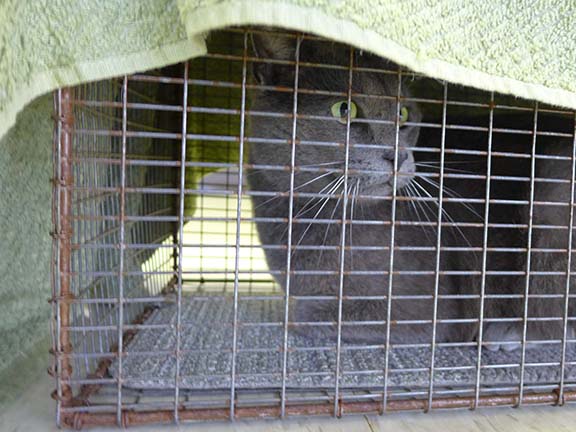Volunteers and non-profits stretch limited resources to slow the growth of feral cat populations
A black cat peers through the bushes, its yellow-green eyes intently watching a white-haired woman spooning canned food into a bowl.
“Crazy cat ladies,” laughed Juli, who helps maintain several colonies of feral cats in neighborhoods around Falls Church, Va., a suburb of Washington, D.C. “Don’t we have anything better to do on our weekends?”
“I don’t,” she continued. “I think this is the most important thing I could be doing, to help these cats.”
There are tens of millions of feral cats in the United States, according to the American Society for the Prevention of Cruelty to Animals. Feral cats are undomesticated and fearful of humans.
Populations of feral cats have enormous growth potential, said Mary Beth Mount, executive director of Caring Hands Animal Support and Education (CHASE), a non-profit dedicated to the health and welfare of animals. “A female cat typically has 2 to 3 litters a year, one after the other,” Mount said, “and can give birth to up to 24 kittens per season.”
Because feral cats instinctively fear humans, they cannot be adopted as pets. Nearly all feral cats brought to shelters are euthanized, according to Alley Cat Allies, a national advocacy organization dedicated to the protection and humane treatment of cats.
Trap-neuter-return, or TNR, is a policy alternative adopted by an increasing number of communities to control feral cat populations. TNR is a method of humanely trapping feral cats, having them neutered or spayed, and releasing them back to where they were originally found.
Martha, a retired federal worker, has been trapping feral cats in communities in Prince William County, Va., for over a decade. She estimates she has trapped “hundreds” of cats. Often, through word of mouth, people will contact Martha for assistance. “I don’t find them, they find me,” said Martha.
Both Juli and Martha asked that their full names not be used, for fear of being inundated with requests.
“As much as I would like to help everybody,” said Martha, “I just can’t do that much work. I am not physically capable of taking care of the whole problem, and not enough people are doing what I’m doing.”
Martha often has a long waiting list of people who have cats they desperately want trapped. However, she only traps when she can take the feral cats the next day to a low-cost spay and neuter clinic.
After surgery, Martha keeps the cats overnight in a recovery room in her basement then releases them back where she found them.
“People really need to understand that it’s better for them to be in their own element even though they’ve just had surgery,” said Martha.
Martha uses her own money and small donations she receives from people she helps to neuter and spay the cats she traps as well as provide vaccinations and any additional veterinarian treatment they receive before being released.
“Other people buy fancy clothes or go to spas, I don’t even care about any of that,” said Martha. “I like cats.”
It is not uncommon for volunteers who help maintain feral cat colonies to use their own money. One of the primary goals of CHASE and other low-cost spay and neuter clinics is to make the cost of surgery and basic medical care as affordable as possible.
“I know that these people are paying out of their own pockets, and they are going down to their last dime,” said Mount. “We want to give them support.”
TNR reduces the number of feral cats but also helps maintain healthier populations.
In addition to neutering or spaying, feral cats brought to clinics are given a thorough medical examination and vaccinated against rabies and distemper, said Dr. Susan McDonough, a veterinarian that works with Animal Birth Control, a low-cost spay and neuter clinic in Millersville, Md., north of Annapolis.
During surgery, feral cats are also eartipped. Eartipping removes a small triangle of skin from the top of the cat’s left ear. This is an effective way to identify – at a distance and without trapping – those feral cats that have already been sterilized and vaccinated.
Once released back into their environment, most cats become trap shy and are unlikely to be captured again.
“With feral cats,” said McDonough, “we only have one chance.”
While the debate continues on how to best manage feral cat populations, many believe that TNR is the best policy.
“It is a hard solution, as there are not enough people dedicated to doing TNR, not enough resources in the community,” said Mount. “But studies have shown that TNR works and there are communities that have been successful.”
“It is the humane solution to the problem,” said Mount.
Elizabeth M. Grieco
American University
March 6, 2013
![]()
Trap-Neuter-Return, or TNR, is a method of humanely trapping feral cats, having them neutered or spayed, and then releasing them back to where they were originally found.
Low-Cost Spay/Neuter Clinics
Here is a list of some of the low-cost spay and neuter clinics in the Washington, D.C. area:
- Animal Birth Control, LLC
- Metro Ferals
- Pets Ltd.
- Potomac Spay/Neuter Clinic
- Spay Now Animal Surgery Clinic
- Spay Spa and Neuter Nook
- Washington Humane Society Spay/Neuter





